Which of the Following Therapeutic Procedures Assists a Person to Learn to Walk Again?
Overview
What is a hip replacement (hip arthroplasty)?
This surgery is where your hip (or parts of information technology) is replaced with a manmade implant (prosthesis). It'south usually performed on adults afterwards other treatments like using a pikestaff or walker, weight loss, medicines and physical therapy have failed to help. You may need a hip replacement because of:
- Osteoarthritis.
- Inflammatory arthritis (rheumatoid arthritis, psoriatic arthritis).
- Femoroacetabular impingement syndrome.
- Injuries, like a hip fracture or dislocation from a fall.
- Developmental hip dysplasia.
- An injury that didn't heal right.
- Osteonecrosis (avascular necrosis).
- Neoplasms.
- Childhood hip disorders, like Legg-Calvé-Perthes affliction and slipped capital femoral epiphysis.
Because all surgery has risks, and prostheses tin neglect as time goes by, your healthcare provider may recommend delaying a hip replacement until severe symptoms are present.
What is the hip?
Your hip is a joint — a ball-and-socket joint — that connects the thigh bone (femur) of your leg to your pelvis. Your femur has a "head" at its meridian that's shaped like a ball, and it fits into the acetabulum (the socket). It's kept in identify by ligaments, tendons and muscles around the articulation. Your hip is the most flexible and complimentary-moving joint in your body and can move backwards and forwards, to the side and tin perform twisting motions.
What are the types of hip replacements?
There are two major types of hip replacements:
- Full hip replacement (the most mutual type): A full hip replacement switches both the femoral caput and the acetabulum with a prosthesis.
- Partial hip replacement: A partial replacement substitutes the femoral caput only. This is typically done for patients with certain types of hip fractures.
What kind of healthcare provider performs hip replacements?
If a hip replacement is the best handling for you, your healthcare provider may send you to an orthopaedic surgeon for evaluation. Your orthopaedic surgeon will evaluate your hip joint with a full concrete exam and Ten-rays and develop a treatment program for how surgery tin best benefit you lot.
How common are hip replacements?
About 370,000 total hip replacements happen every yr in the U.S.
What symptoms may bespeak that I need a hip replacement?
Some of the post-obit symptoms may exist related to conditions that hip replacements address. They include:
- Pain in the inductive hip or groin.
- Pain in the buttock and trochanteric region.
- Pain with activeness and at rest.
- Pain that gets worse when you put weight on the leg.
- Stiffness/tightness of the hip.
- Loss of movement.
- Difficulty sleeping.
- Difficulty walking.
- Difficulty putting on shoes and socks.
Who shouldn't go through a hip replacement?
Hip replacement surgery isn't for everyone. Fifty-fifty if someone is in hurting and can't move their hip as well equally expected, they aren't automatically considered for a hip replacement. Y'all might be ineligible if you have:
- Severe medical problems such every bit heart failure, anemia, recent myocardial infarction (middle attack), unstable angina and more than. Talk to your healthcare provider about issues that may disqualify yous.
- An active infection.
- An immature skeleton.
- Irreversible or permanent musculus weakness.
- Paraplegia, quadriplegia.
- A neuropathic (Charcot) articulation.
- Astringent morbid obesity.
Procedure Details
Is a hip replacement surgery outpatient or inpatient?
Most people need to stay in the infirmary for nigh one to two days.
How do I prepare for surgery? What happens earlier a hip replacement?
In order to prepare for surgery, y'all'll schedule a series of appointments to receive testing and clearance. During these appointments, studies including lab testing, urine assay, an EKG and X-rays may be performed. Based on the results of these tests and your health history, clearance is or is not initiated for the surgery.
Before surgery, your medical risk will be assessed. Your healthcare providers need to make sure that the risks of a hip replacement don't outweigh the benefits. They will check for:
- How broken-hearted/stressed yous are near your surgery.
- How well you'll handle claret loss.
- How well you might tolerate anesthesia.
- How you lot might manage the rehabilitation process.
- How your other medical issues may bear upon your healing.
- How active you lot are.
- How appropriate your weight is.
Your lower extremities will be evaluated earlier surgery. Your healthcare providers will practise the following:
- Muscle testing: Strength of the hip flexors, extensors, abductors and adductors. Also the forcefulness of the limb below the hip.
- Nerve and vascular status testing: Sciatic and perineal nerve function testing, sensory examination and an assessment of the arterial pulses. Checking if in that location's any severe vascular affliction.
- Palpation testing: Palpation helps rule out other causes of hip pain which are not from the joint
- General inspection: Examining your gait (walk), any previous incisions, aberrant swelling, cuts, discolorations and infections.
- Range of motion testing: Hip flexion/extension, abduction/adduction and internal/external rotation.
- Trendelenburg sign: Tests the force and function of the hip abductor muscles.
- Measure your leg length.
- Directly leg ascension: Testing groin pain, radiating pain (pain that starts in one place and travels to another), back pain, posterior hip pain and lower leg pain.
Y'all will have radiographs (X-rays) of the hip and pelvis to appraise the status and structure of the hip joint. Occasionally advanced imaging (MRI or CT browse) may exist needed to assist in the diagnosis or handling planning.
Your healthcare provider will probable require some tests before surgery. Tests may include:
- Complete claret count (CBC).
- Prothrombin time (PT).
- International normalized ratio (INR).
- Activated partial thromboplastin fourth dimension (aPTT).
- Claret type/screen.
- Basic chemistries.
- Urinalysis.
- Other tests, as needed.
- Electrocardiogram (ECG).
You can besides take some steps to help ensure an easier and safer recovery after surgery. Make a few simple changes around the house, and arrange for someone to aid you following surgery. If yous smoke, quit or cut downward to better your surgery risk and recovery charge per unit. Information technology's also helpful to lose weight if needed, have an obstructive slumber apnea screening, and endeavor to resolve other conditions you have. Don't consume or beverage anything later on midnight the night before surgery.
You can try these tips at home prior to surgery:
- Remove whatever loose rugs, as they tin can be chancy when you're walking in the house. Make sure you lot tape down all electrical cords.
- Store additional canned and frozen foods, and make sure all supplies are betwixt waist and shoulder level.
- Set up a sleeping accommodation on the primary flooring, or brand sure that you but have to climb the stairs once a day.
Special equipment can help ensure an easier recovery following surgery. Your physical and occupational therapists volition recommend equipment for you and will aid yous and your family get this equipment following surgery. Some of this equipment may include:
- Elevated toilet seats.
- Shower seats.
- Handrails and catch bars.
- Grasping device for putting on socks and shoes.
Do I all the same have my normal medications before surgery?
Inform your surgeon nearly all of your medications, both over-the-counter and prescription. Some medications don't react well with anesthesia, and others such as aspirin, ibuprofen and blood thinners increase bleeding. For these reasons, you lot may need to stop taking certain medications earlier your hip replacement. If you're taking aspirin or aspirin-based medication for arthritis, you must cease taking these two weeks before your surgery. If you're taking medications for other medical issues, don't discontinue taking these without checking with your primary healthcare provider. Make certain to bring a listing of all medications, the dosages and how often you lot take them. This includes all herbal supplements and vitamins. This is important information that will be documented in your infirmary records.
Why do I accept to run into the dentist before surgery?
Have your teeth cleaned and make certain you lot don't have whatsoever cavities that might need to be taken care of during the first few months following surgery. Since the blood supply to your hip is increased during healing fourth dimension, information technology's better to take any routine dental piece of work done either before surgery or iii months subsequently. In addition, any emergencies must be taken care of immediately. Your surgeon may recommend antibiotics prior to whatsoever dental procedure in one case you have a total joint replacement.
What medications will I receive correct earlier, during, and right after the hip replacement?
- Antibiotics: Medication to help prevent infection.
- Anesthesia: An anesthesiologist volition meet with you lot earlier your surgery. They will explain the diverse types of anesthesia available to you and the risks and benefits of each with your health history. The spinal, or regional anesthetic block, is the almost mutual method used for orthopaedic joint replacement procedures. You'll likewise be asked to complete a health questionnaire from the anesthesia department for surgery clearance to ensure your safety.
- Thromboprophylaxis: Medication to help foreclose blood clots (thrombosis).
- Pain control: Diverse medications can aid command pain, including NSAIDs, narcotic hurting medications and peripheral nerve block.
When do I see a physical therapist?
You may be evaluated past a concrete therapist before surgery. Later surgery, y'all'll have daily concrete therapy.
Do I need to do before surgery?
Information technology's important to do strengthening exercises and conditioning prior to surgery to aid ensure a better effect and recovery. Existence stronger prior to surgery is a big benefit and helps in your rehabilitation program progress. The following exercises are recommended prior to surgery:
- Tighten muscles in the thigh, so straighten your knee joint flat. Hold for a count of 5 so relax. Do 10 times, twice a day.
- Tighten buttocks, pushing heels down into the bed. Hold for a count of v so relax. Do ten times, twice a solar day.
Keep in mind that it tin can take over a yr for your muscles to become strong, so it's extremely of import to do your exercises to help ensure a prophylactic and effective recovery.
What is the prosthesis made of?
The prosthesis is constructed of metallic and plastic. Titanium, stainless steel, cobalt-chromium, ceramic and polyethylene are the almost common materials. A prosthesis for a total hip replacement consists of four components:
- Femoral stalk.
- Femoral head.
- Acetabular liner.
- Acetabular shell.
They are linked, but flexible, and so that the surgeon tin can adjust for anything unexpected. The prosthetic is then stock-still to the remaining os using either:
- Fixation to the host bone by relying on a bony ingrowth onto or into the porous surface of the bone that has either been "interference-fit" or "printing-fit" into the surrounding os.
- Medical cement (methylmethacrylate cement), if the original bone's quality is low.
How long does the surgery terminal?
One to two hours is typically how long the surgery takes.
Risks / Benefits
What are the benefits of a hip replacement?
Relief from pain is the greatest benefit and the major reason for hip replacement surgery. The process offers other benefits, including:
- Improved movement.
- Improved forcefulness.
- Improved coordination of the torso and leg.
- The ability to walk, climb stairs and maintain an agile lifestyle in greater comfort.
What are the risks of surgery? What are the possible complications?
There are some risks and complications that may happen through a hip replacement surgery associated with anesthesia, including respiratory or cardiac malfunction. Other complications that tin can happen right later on surgery or fifty-fifty years later include:
- Blood clots. About 1% of people who get through a hip replacement volition have a claret jell in their leg (deep vein thrombosis) or lungs (pulmonary embolism).
- Infection. This is uncommon — it happens to 0.4% to 1.5% of people who undergo a hip replacement.
- Loosening. The loosening of the implant caused by wear and tear is a common long-term trouble that happens far less than information technology used to. This happens less and less as prosthetic materials and surfaces become better.
- Breakage. Sometimes old implants can interruption down. Less than 0.v% of people end up with a broken implant.
- Change in leg length. The lengths of your legs will be measured before, during and after your surgery. Rarely, individuals finish up with one leg longer than another, and need a shoe lift to even them out.
- Injury to nerves and claret vessels.
- Fracture.
- Weakness.
- Stiffness or instability of the joint. Your joint may stiffen considering of heterotopic ossification, which is where soft tissues harden into bone.
- Demand for additional surgeries.
- Dislocation. Sometimes the brawl tin can separate from the socket. This happens to less than ii% of people.
People at an increased take chances for complications are those with severe rheumatoid arthritis or systemic lupus. In addition, individual with obesity, diabetes, malnourishment, hemophilia or those who have had previous prosthetic joint infections are at higher risk. Make sure to contact your orthopaedic surgeon immediately if you feel any of these problems after surgery.
Recovery and Outlook
What happens after surgery?
After surgery, you'll exist given pain medication and an antibody. Medicines or physical therapy may be prescribed by your surgeon to forestall blood clots. To subtract your chances of having a Deep Vein Thrombosis (DVT) afterward surgery, you may exist given medication, wearable special stockings and do ankle pumps for 2 to three days following surgery. You may have an appointment depending on the wound closure method preferred by your surgeon to have the staples or external sutures removed (if present). Y'all should call your surgeon if you experience any of the following symptoms:
- Increased redness.
- Pain or swelling.
- Drainage at the incision.
- Bumps or pimples.
- Any other changes you question.
Concrete therapy will start within 24 hours.
How long will I be in the infirmary?
You may be in the infirmary upwards to 2 days subsequently surgery. If it is unsafe for you to return directly home from the hospital, you might take to get to a rehabilitation centre prior to belch dwelling. Talk to your healthcare provider about the all-time recovery plan.
How long that ends up being in the hospital depends on three things:
- If your pain is under control: You won't get home if your hurting is unbearable.
- How well you safely move effectually: You won't go home if information technology looks like you might be unsafe in that location.
- How stable you are, medically: You won't go home if, for instance, your blood pressure is too high.
What does recovery look similar? What's the rehabilitation after hip replacement surgery?
Rehabilitation and physical therapy are started immediately post-obit surgery and continue throughout hospitalization and at home for one yr after surgery. Your physical therapist will monitor the strength and flexibility in your leg and hip, likewise as your ability to stand and sit. In addition, a physical therapist will provide goals and instructions for yous to complete while in the hospital and at domicile.
Although discharge domicile is the goal for the majority of patients, your healthcare provider may determine that information technology's all-time for your recovery if you lot go to a rehabilitation center or nursing dwelling house after discharge from the hospital. At the rehabilitation centre, you volition have full-bodied time with a physical therapist and occupational therapist and will regain your force, acquire nearly all your exercises and the precautions that you'll need to follow. Your length of stay at this facility is approximately five to xiv days, depending on your recovery progress. Your healthcare provider's banana or nurse will discuss facilities available for your needs, and a case manager specializing in discharge planning will encounter with yous during your admission. The case manager handles all of the planning for your rehabilitation.
How long is the recovery period after surgery? How long will I have to perform physical therapy exercises?
Several variables affect the ultimate success of a hip replacement surgery and the length of the recovery time. These include the strength of your basic and muscles and your full general health and lifestyle. Delivery to a rehabilitation program is also an important part of the recovery process, since improvement to the hip joint is determined past your rehabilitation efforts.
Y'all'll perform daily exercises that strengthen and stretch the muscles around your hip joint — likely 20 to 30 minutes ii to iii times per twenty-four hour period. You'll also slowly return to climbing stairs, bending and walking, gradually regaining motion and forcefulness. It will be several weeks to several months before you're completely back to normal.
Will I demand surgery over again?
Joint replacements don't last forever — although experts have noticed that modern prostheses tin can terminal longer than the ones that were used years ago. Hip revision surgery may get necessary if an artificial hip becomes painful.
How long before I can drive?
Do not drive for several weeks after surgery. You may resume driving once you lot accept skillful strength and control of the legs, are comfortable sitting in a car, and are off of pain medication. Discuss this with your surgeon based on your recovery.
How will I accept to limit my movement post-obit surgery?
After surgery, your concrete therapist will instruct you regarding hip motility precautions and whatsoever limitations y'all may take for range of move. Proceed in listen that your physical therapy and strengthening exercises will assist you proceeds greater mobility and ensure an easier recovery following surgery. It'south highly recommended that you go on therapy treatment for the recommended timeframe prescribed by your physical therapist.
Your physical therapist will tell you that there are several basic rules about positioning that you should be aware of following surgery. The specific precautions will vary based on the surgical arroyo (window into the hip joint) used during surgery. Precautions may include that you don't bend forward more than 90 degrees, and practice not lift your knee on the surgery side college than your hip. Too, don't cross your legs or rotate your leg outward, or twist or pivot your operated hip.
How can I manage at home during recovery from hip replacement surgery? What are hip replacement precautions and restrictions?
There are some general safe tips to keep in heed. For example, simplify your surround:
- Remove clutter.
- Continue stairs free of objects.
- Continue supplies in the same identify.
- Remove pocket-sized rugs throughout the house.
Go on walking areas rubber:
- Lookout man out for your pets when walking.
- Keep hallways/stairways well lit.
- Purchase night lights for bedrooms and bathrooms.
- Stairs should take securely attached handrails. Not-skid threads on stairs add together to safe. If you lot accept problems with your vision, add a contrasting color to mark stair edges.
When to Telephone call the Doctor
What side effects of hip surgery hateful that I should contact my orthopedic surgeon?
You should contact your surgeon correct abroad if you experience whatsoever of the post-obit:
- Drainage at the incision.
- Bumps or pimples.
- Increased redness.
- Pain or swelling.
- Any other changes you question.
How frequently should I schedule follow-upwardly appointments with my healthcare provider?
Postal service-operative visits assistance your surgeon know that your hip is healing well. Brand certain to schedule your beginning evaluation inside the timeframe your surgeon recommends. It's important to comply with this schedule and to see your healthcare provider regularly for routine office visits to ensure rubber and effective recovery from total hip replacement.
Additional Details
How do I safely remainder and sleep after a hip replacement?
Drag both of your legs when sitting to minimize swelling. When resting or sleeping in bed, lie on your non-operative side for the start 4 to six weeks following surgery. Brand sure you have a pillow between your legs and a second pillow to support your pes and talocrural joint. When you lie on your back, you must have a pillow betwixt your legs. If you get upwardly in the centre of the night, sit at the side of the bed for a few seconds to avert dizziness.
How practise I safely sit and stand later on a hip replacement?
At that place are 3 steps to sitting downward after a hip replacement:
- Back up to the bed/chair until the backs of your knees are touching it.
- Reach your hands back for the armrests. Hold your weight nonetheless.
- Lower your torso slowly into a seated position. Avoid bending frontwards at your trunk.
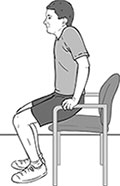
Go along the post-obit tips in mind while you lot're sitting:
- Sit on a firm chair with a direct back and armrests. Keep your hips and knees at xc degrees (i.e., knees below hips).
- Don't sit down on low, soft or overstuffed furniture that may crusade excessive bending of your hip.
- Follow the precautions and weight-begetting status equally instructed by your healthcare provider or physical therapist.
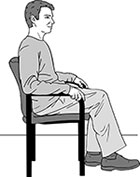
To stand, follow these two steps:
- Scoot to the edge of the bed/chair. Avoid bending forwards at your trunk.
- With your hands on the bed or chair, push up to the continuing position. Bring ane hand at a time up to your walker.
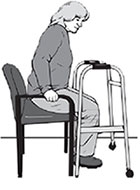
How exercise I safely reach for objects subsequently a hip replacement?
Reaching typically requires also much angle and is typically non comfy for people post-obit hip surgery. It's recommended that for the start four to six weeks afterwards surgery, you employ long handled reachers. You can get reachers from your occupational therapist or a medical supply store.
How practise I safely get dressed later a hip replacement?
For dressing, to prevent lifting your knee joint college than your hip on the surgery side, y'all may demand a long shoehorn and a dressing stick which will help you with your shoes, socks and pants. Remember to e'er put your operative leg in your pants offset. If you clothing shoes with shoe ties, endeavor switching to rubberband shoelaces.
How exercise I safely utilise the bath and bathe afterward a hip replacement?
Continue a portable toilet (or a urinal) if a bath is far from your bedroom. Don't endeavour to become into the bathtub or to apply an overhead shower. Use a walk-in type shower or take a sponge bath until 11 days following your surgery.
How do I safely walk after a hip replacement?
You'll need to use a walker or crutches which your occupational or concrete therapist will provide for you. Brand certain to stay on your crutches or walker until your healthcare provider or physical therapist advises that yous utilise a cane. Your provider will decide how much weight you lot can put on your surgery leg. In most cases, you lot will be able to put 100% of your weight on your surgery leg.
Your physical therapist will assist you learn how to utilise your walker or crutches correctly and aid you become the correct equipment. A handbag or basket attached to your walker volition permit you to deport modest items when walking. Keep in listen that walking does take try following surgery. While physical therapy volition help yous learn how to correctly apply a walker or crutches, your recovery is based on your dedication to therapy and exercises post-obit surgery.
How do I become safely upward and down stairs later a hip replacement?
Your concrete therapist will teach yous the right style to become up and downwards stairs using handrails and/or crutches. Call back to employ your good leg first, followed by the crutches and the surgery leg. When going down stairs, the crutches and surgery leg become starting time, followed past the good leg.
How tin I safely have sex later on a hip replacement?
For positioning during sexual relations, make sure to consult your healthcare provider. Intercourse may be resumed approximately three weeks after surgery, following the precautions outlined past your provider.
What chores tin can I safely exercise after a hip replacement?
Remember not to bend also far or stoop when performing household chores. Chores that y'all should avert that may involve excessive angle include cleaning the flooring, taking out the trash and making beds.
How practice I safely ride in a car and on a aeroplane after a hip replacement?
You may exit in a car (as a passenger) approximately iii weeks after you lot return habitation, but make sure to avert sports cars and cars with bucket seats because of the low seat acme. When riding in a car, make certain to finish every 45 to sixty minutes to go out and do some walking. Too, practice talocrural joint pumps in the machine while riding. If you're flying, request an alley seat and keep the operative leg extended in the aisle. Request to be boarded last on the airplane.
How should I get into a car after my total hip replacement?
- The front end passenger car seat should be pushed all the manner back before you enter the car.
- Have the driver park on a flat surface and/or well-nigh the driveway ramp.
- Walk toward automobile using the appropriate walking device.
- When shut to the car, turn and begin backing up to the forepart passenger auto seat. Never step into the car.
- Reach with your right manus and concord the door frame or headrest. Place your left hand on the car seat or dashboard.
- Slowly lower yourself to the automobile seat.
- Slide yourself back onto the automobile seat.
- Swing your legs into the auto. Try to move 1 leg at a time. Keep your toes pointed up. Don't cantankerous your legs.
- Reverse these steps to go out of a car.

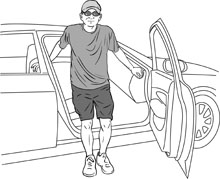
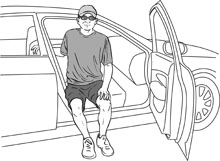
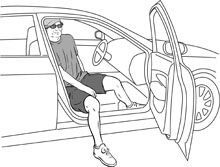
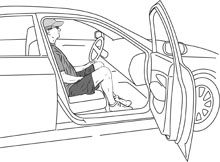
Frequently Asked Questions
Can a hip replacement affect the bladder?
Your hip replacement surgery shouldn't touch your float. Contact your healthcare provider if yous're concerned nearly new symptoms.
Can I play sports after a hip replacement?
Hullo-affect sports like running are more often than not not recommended. After you recovery from your surgery, and with your healthcare provider's permission, yous may resume low-impact sports like walking, cycling, swimming and golf. Be sure to discuss your desired activities with your surgeon.
What are the survival rates for a hip replacement?
Survival rates are loftier. Less than 1% of people who take a hip replacement pass abroad inside 90 days post-obit the surgery.
A annotation from Cleveland Clinic
A hip replacement is a major surgery for people whose daily life is severely afflicted by debilitating hip pain and loss of range of motility. Deciding to pursue a hip replacement is a decision that should non be taken lightly. There are possible complications, and recovery can have months.
Source: https://my.clevelandclinic.org/health/treatments/17102-hip-replacement
0 Response to "Which of the Following Therapeutic Procedures Assists a Person to Learn to Walk Again?"
Post a Comment